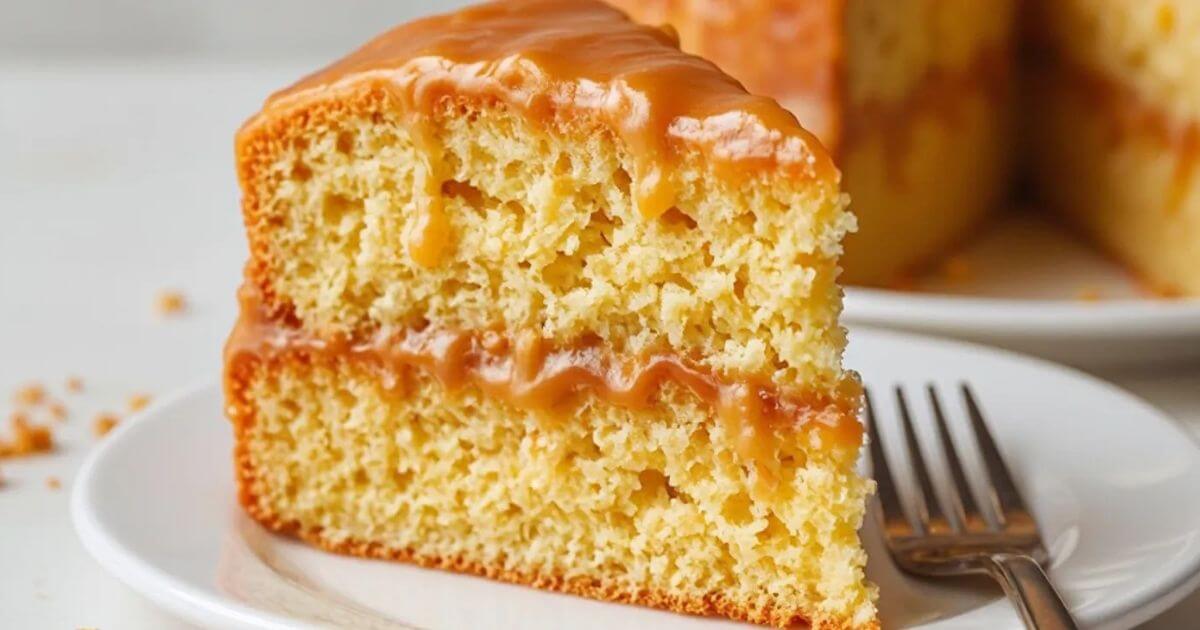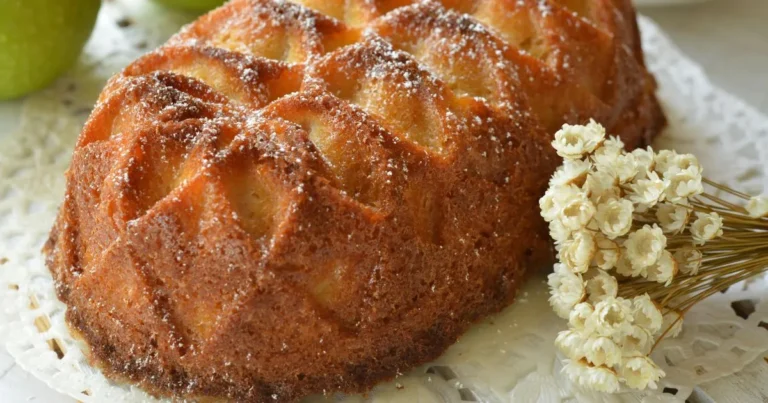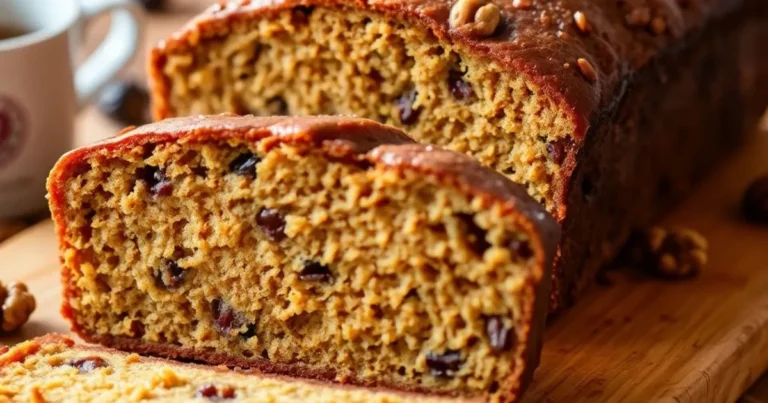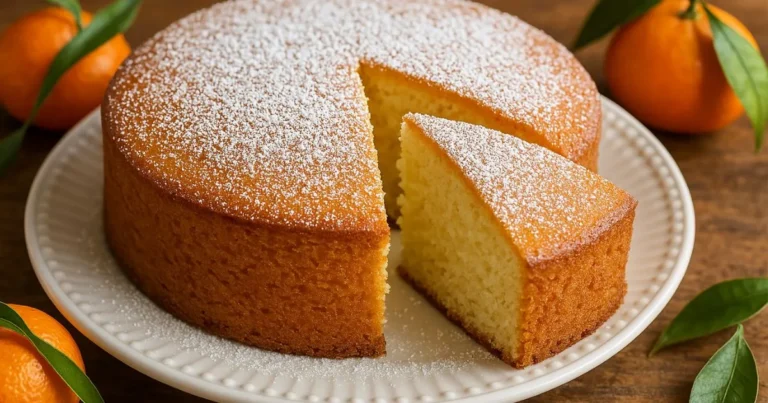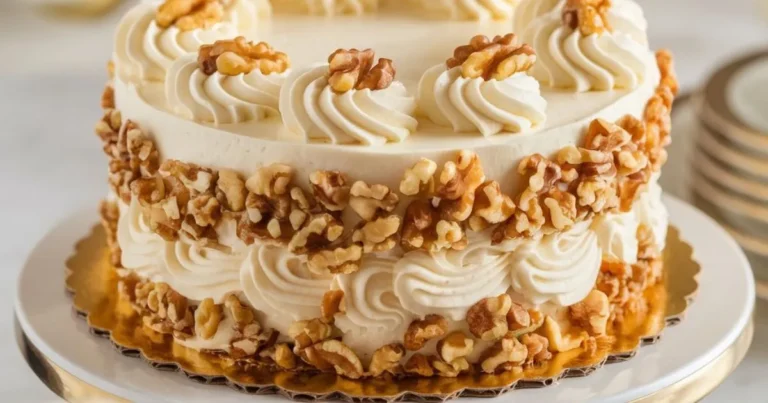Caramel Cake Recipe: How to Make It in One Bowl
The rich, buttery aroma of caramel wafting through your kitchen is one of life’s simple pleasures. A homemade caramel cake brings together the comforting sweetness of caramel with the tender crumb of a perfectly baked cake – a combination that has delighted dessert lovers for generations. This classic Southern treat dates back to the early 1900s when homemakers discovered that cooking sugar to a caramel state before adding it to cake batter created a uniquely deep flavor profile that plain vanilla cakes couldn’t match.
What makes this caramel cake recipe special is its simplicity – everything comes together in just one bowl, saving you time and cleanup. Perfect for special occasions or weekend baking projects, this caramel cake recipe delivers impressive results without complicated techniques. Whether you’re an experienced baker or just starting out, this recipe strikes the perfect balance between accessible and impressive.
Let’s dive into this foolproof caramel cake recipe that will have your family and friends asking for seconds.
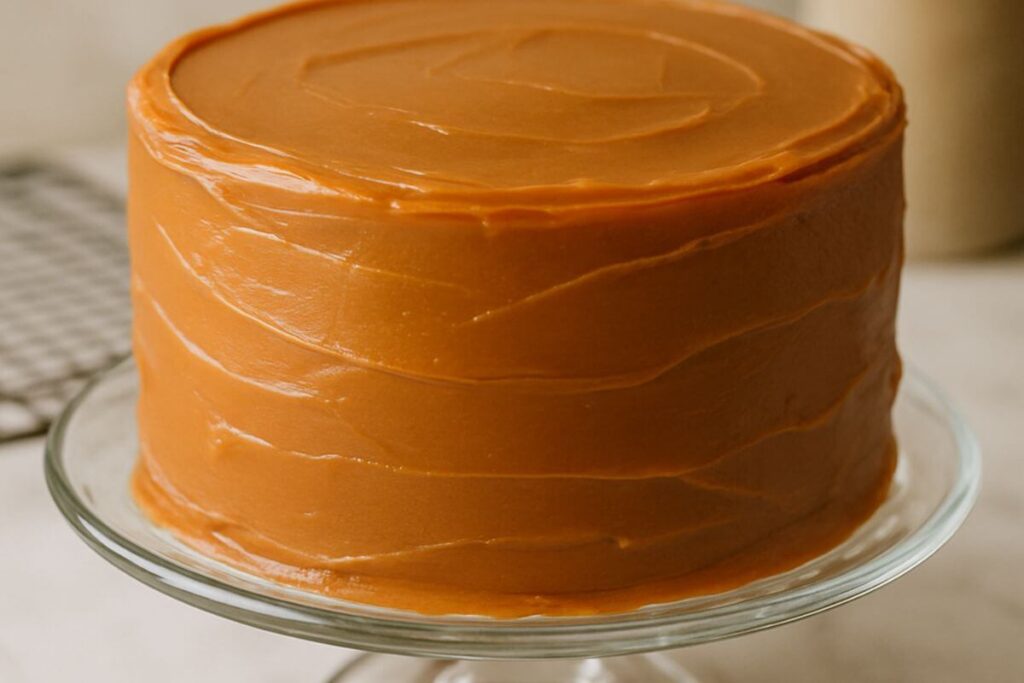
Table of Contents
Ingredients
For the Cake:
- 2½ cups all-purpose flour
- 2 cups granulated sugar
- 1 cup unsalted butter, softened
- 1 cup buttermilk, room temperature
- 4 large eggs, room temperature
- 1 teaspoon baking powder
- ½ teaspoon baking soda
- ½ teaspoon salt
- 2 teaspoons vanilla extract
For the Caramel Frosting:
- 1 cup unsalted butter
- 2 cups packed brown sugar
- ½ cup heavy cream
- 4 cups powdered sugar, sifted
- 2 teaspoons vanilla extract
- ¼ teaspoon salt
Substitutions:
- Dairy-free option: Replace butter with equal amounts of vegan butter and use coconut milk instead of buttermilk
- Gluten-free option: Substitute all-purpose flour with a 1:1 gluten-free flour blend
- No buttermilk? Mix 1 cup of milk with 1 tablespoon of lemon juice or white vinegar and let sit for 5 minutes
Equipment Needed
- 9-inch round cake pans (two)
- Large mixing bowl
- Electric mixer (stand or handheld)
- Rubber spatula
- Measuring cups and spoons
- Wire cooling rack
- Medium saucepan (for frosting)
- Parchment paper
Alternative tools: If you don’t have an electric mixer, you can use a wooden spoon and mix by hand (requires more effort). A whisk can substitute for a mixer when combining wet ingredients.
Step-by-Step Instructions
- Prepare your workspace. Preheat your oven to 350°F (175°C). Lightly grease two 9-inch round cake pans and line the bottoms with parchment paper. This step helps prevent sticking and allows for easy cake removal.
- Combine the wet ingredients. In your large mixing bowl, beat the softened butter and granulated sugar with an electric mixer on medium speed until light and fluffy, about 3-4 minutes. This step incorporates air into the batter, creating a lighter cake texture.
- Add the eggs. Beat in the eggs one at a time, ensuring each is fully incorporated before adding the next. This prevents the batter from curdling and helps maintain a smooth consistency.
- Mix in the flavorings. Add the vanilla extract and mix until combined. The vanilla enhances the caramel flavor without overpowering it.
- Combine the dry ingredients. In a separate bowl, whisk together the flour, baking powder, baking soda, and salt. This helps evenly distribute the leavening agents throughout the batter.
- Create the batter. Gradually add the dry ingredients to the wet mixture, alternating with buttermilk (beginning and ending with dry ingredients). Mix on low speed after each addition, just until incorporated. Overmixing can lead to gluten development, making the cake dense and tough.
- Divide and bake. Divide the batter evenly between the prepared cake pans.Gently tap each pan on the counter to remove any trapped air bubbles. Bake for 25–30 minutes, or until a toothpick inserted into the center comes out clean with a few moist crumbs attached.
- Cool completely. Allow the cakes to cool in the pans for 10 minutes before transferring to a wire rack to cool completely. The cakes must be fully cooled before frosting to prevent the caramel frosting from melting.
- Make the caramel frosting. In a medium saucepan over medium heat, melt the butter. Add the brown sugar and stir constantly until dissolved. Bring to a gentle boil for 2 minutes without stirring. Remove from heat and stir in the heavy cream carefully (mixture will bubble). Let cool for 15-20 minutes.
- Finish the frosting. Transfer the cooled caramel mixture to a large bowl. Gradually beat in the sifted powdered sugar, vanilla extract, and salt until smooth and spreadable. If the frosting is too thick, add a tablespoon of cream; if too thin, add more powdered sugar.
- Assemble and frost. Place one cake layer on a serving plate. Spread approximately 1 cup of frosting evenly over the top. Place the second layer on top and cover the entire cake with the remaining frosting. Begin by frosting the top and then work your way down the sides.
- Create decorative swirls. For a professional-looking finish, use the back of a spoon to create decorative swirls in the frosting. Let the frosting set for at least 30 minutes before serving.
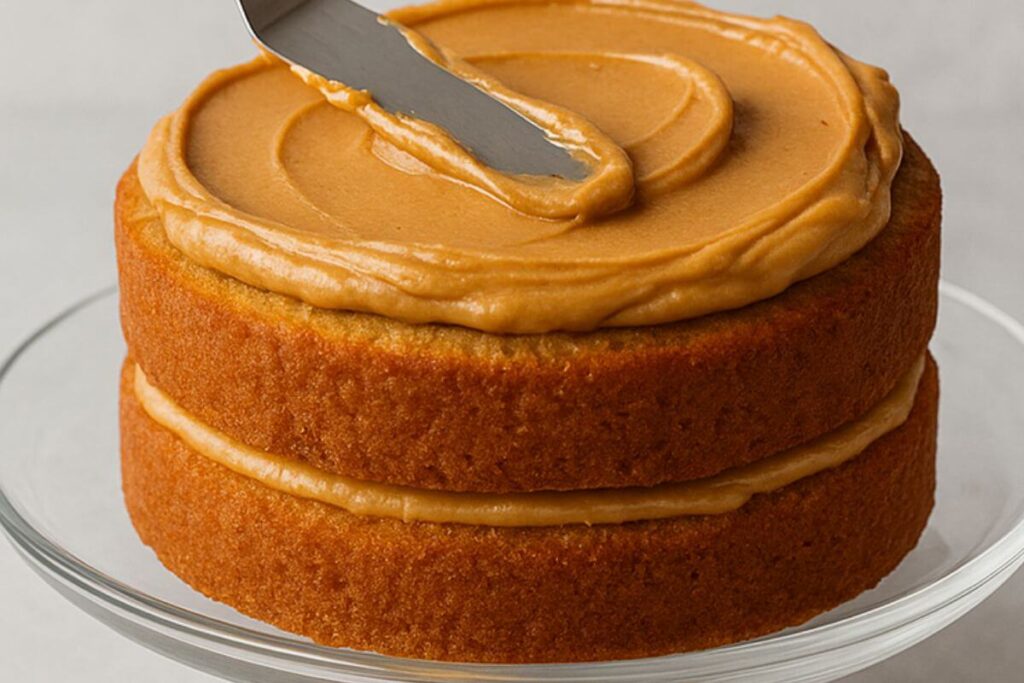
Expert Tips & Variations
- Room temperature ingredients are essential. Cold ingredients don’t blend properly and can result in a dense cake.
- Don’t rush the butter-sugar creaming process. The mixture should be noticeably lighter in both color and texture, which takes at least 3-4 minutes of beating.
- Check your cake for doneness correctly. A toothpick inserted in the center should come out with a few moist crumbs—not wet batter. A completely clean toothpick can indicate an overcooked cake.
- For extra caramel flavor in the cake, add 1/4 cup of caramel sauce to the batter before baking.
- Watch the caramel carefully when cooking. It can go from perfect to burned very quickly. If it smells bitter or turns dark brown, you’ll need to start over.
- For a salted caramel version, increase the salt in the frosting to 1/2 teaspoon and sprinkle flaky sea salt on top before serving.
- Make it a layer cake with flavor variations by adding sliced bananas or a thin layer of chocolate ganache between cake layers.
Nutritional Information
Per serving (1/12 of cake):
- Calories: 620
- Total Fat: 28g
- Saturated Fat: 17g
- Cholesterol: 120mg
- Sodium: 240mg
- Total Carbohydrates: 89g
- Dietary Fiber: 0g
- Sugars: 72g
- Protein: 4g
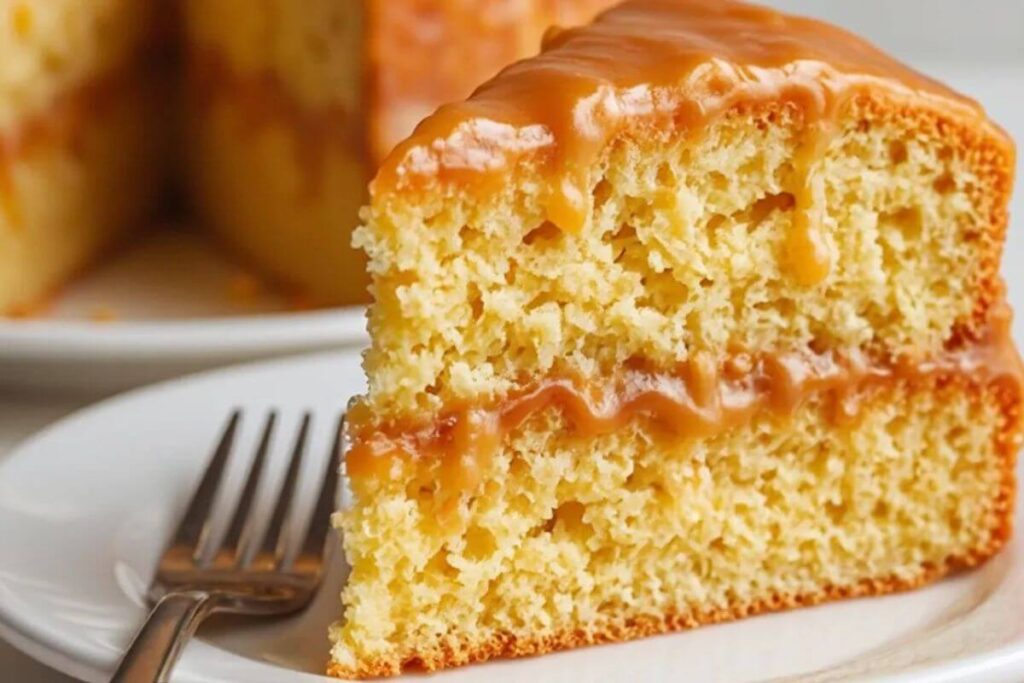
Health benefits:
- The eggs in this caramel cake provide high-quality protein and essential vitamins.
- Using real butter rather than margarine avoids trans fats.
- When enjoyed in moderation, this caramel cake can be part of a balanced diet.
Disclaimer: Nutritional values are estimates only and may vary based on specific ingredients used.
Storage & Reheating Instructions
Room temperature storage: Store the frosted caramel cake in an airtight container at room temperature for up to 2 days. The caramel frosting forms a slight crust that helps preserve the cake’s moisture.
Refrigerator storage: For longer storage, refrigerate the cake for up to 5 days. Place in an airtight container to prevent it from absorbing odors and drying out.
Freezing instructions: This caramel cake freezes beautifully! Wrap individual slices or the entire unfrosted cake tightly in plastic wrap, then aluminum foil, and freeze for up to 3 months. Thaw overnight in the refrigerator before serving or frosting.
Reheating suggestions: While this cake is delicious cold or at room temperature, you can warm individual slices in the microwave for 10-15 seconds for that fresh-baked taste. The caramel frosting will soften slightly when warmed.
Serving Suggestions
- Classic pairing: Serve a slice of caramel cake with a scoop of vanilla ice cream for a delightful temperature and texture contrast.
- Coffee companion: The rich caramel flavor pairs perfectly with a cup of freshly brewed coffee or espresso.
- Elegant presentation: Garnish each slice with a drizzle of warm caramel sauce and a sprinkle of chopped toasted pecans for texture and visual appeal.
- Complete the meal: Follow a light dinner of grilled chicken and roasted vegetables with this caramel cake for a satisfying dessert that won’t feel too heavy.
- Beverage pairings: Beyond coffee, this cake pairs beautifully with black tea, a glass of cold milk.
FAQ:
Why did my caramel frosting harden too quickly?
Caramel frosting can set rapidly as it cools. If it becomes too firm while you’re frosting the cake, gently warm it by placing the bowl over a pan of simmering water and stirring until it reaches a spreadable consistency again. Alternatively, add a tablespoon of warm cream and mix well.
Can I make this caramel cake in advance?
Absolutely! You can bake the cake layers up to two days ahead and store them well-wrapped at room temperature. The caramel frosting is best made fresh on the day you plan to assemble the cake, as it can harden if made too far in advance.
Why did my cake turn out dense instead of fluffy?
Dense cakes usually result from overmixing the batter or using cold ingredients. Ensure your eggs and buttermilk are at room temperature and mix just until ingredients are combined. Make sure your baking powder and baking soda are fresh as well.
Can I turn this recipe into cupcakes?
Yes! This caramel cake recipe makes approximately 24 cupcakes. Fill cupcake liners 2/3 full and bake at 350°F for 18-20 minutes. The caramel frosting works beautifully piped onto cupcakes.
How can I prevent my cake layers from doming too much?
For flatter cake layers, wrap cake strips (dampened fabric strips) around your pans before baking. Alternatively, you can gently level the cakes after baking by trimming the tops with a serrated knife once they’re completely cooled.
Is there a way to make this cake less sweet?
To reduce the sweetness, you can cut the sugar in the cake batter by up to 1/4 cup without affecting the texture significantly. For the frosting, increase the salt to 1/2 teaspoon to balance the sweetness and consider using unsweetened cream.
Can I use dark brown sugar instead of light brown sugar for the frosting?
Yes! Dark brown sugar contains more molasses and will give your caramel frosting a deeper, more intense flavor. It’s a wonderful variation if you prefer a stronger caramel taste.
Conclusion
This one bowl caramel cake recipe combines simplicity with spectacular results. The tender cake layers infused with vanilla perfectly complement the rich, buttery caramel frosting. What makes this caramel cake recipe special is how accessible it is for bakers of all skill levels while still delivering that wow-factor that homemade desserts should have.
Whether you’re preparing this caramel cake for a special celebration or simply treating yourself and loved ones to something sweet, the harmonious blend of flavors and textures is sure to impress. The time-tested combination of butter, sugar, and vanilla transformed into this delectable caramel creation proves that sometimes the most straightforward recipes yield the most satisfying results.
Happy baking, and enjoy every blissful bite of your homemade caramel cake!

